四轮香 Hanceola sinensis
- Scientific Name: Hanceola sinensis (Hemsl.) Kudô
- Ref: Mem. Fac. Sci. Taihoku Imp. Univ. 2:54. 1929
- Synonym: Hancea sinensis Hemsl.
- Chinese Common Name: 四轮香 sìlúnxiāng
- Family: Lamiaceae
- Genus: Hanceola
- Distribution: Subtropical evergreen and mixed forests; 1200-2200 m. Guangxi, Guizhou, Hunan, Sichuan, Yunnan.
- Photo: Mt. Emei, Sichuan
Herbs perennial. Rhizomes thick, woody. Stems erect, solitary, 0.5-1.5 m, puberulent. Petiole 1-1.5 cm, puberulent; leaf blade lanceolate to obovate-lanceolate, 10-25 × 4-11 cm, adaxially sparsely minutely hispid-puberulent, ± densely so on veins, abaxially subglabrous, glandular, sparsely puberulent on veins, base attenuate to cuneate-decurrent, margin coarsely serrate-dentate, apex acuminate to caudate-acuminate. Racemes or panicles axillary and terminal, to 13 cm; bracts oblanceolate to lanceolate, margin dentate. Pedicel 05-7 mm; peduncle 2-5 mm. Calyx ca. 4 mm, puberulent, obscurely 10-veined; teeth triangular, apex long acuminate, posterior tooth larger; fruiting calyx to 1 cm. Corolla white, yellow, to purple, to 3.5 cm; tube arcuate, throat to 1 cm wide, puberulent outside and inside near base; upper lip ca. 3 mm; lower lip ca. 6 mm, middle lobe to 6 mm, lateral lobes 4 mm. Stamens included; filaments puberulent. Nutlets 3.5 × 2 mm. Fl. Jul-Aug, fr. Sep. (Flora of China)

Mt. Emei, Sichuan
